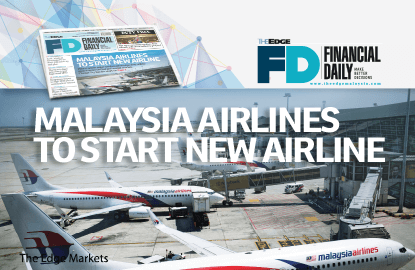
KUALA LUMPUR: Malaysia Airlines Bhd, a wholly-owned subsidiary of Khazanah Nasional Bhd, has aborted plans to sell some of its Airbus A380 super-jumbos and instead will use all six of them to set up a new airline to serve the haj and umrah market.
Its group managing director and chief executive officer (CEO) Peter Bellew said the group is working towards finalising plans for the formation of a new airline, which is expected to be operational by end-2018.
“We will apply for the licence [to start the new airline] next year. The plan is to hang on to these A380s for now until the six new A350s arrive in October 2017 through April 2018. We will then fly the A350s on routes between Kuala Lumpur and London (leaving the A380s to be utilised by the new airline),” he told The Edge Financial Daily over the phone yesterday.
In a statement yesterday, the national carrier said it is already transporting Muslim pilgrims on charter flights to Saudi Arabia “successfully and is in a good position to cater for increased passenger demand on this route”.
According to Bellew, Malaysia Airlines is using one of the A380s to serve the haj and umrah market. The airline carried about 70,000 passengers on this route during the nine-month period ended Sept 30, 2016.
Malaysia Airlines has been trying to dispose of its A380s for a while now. It had attempted to sell two of its six A380s in 2015, but did not find buyers and so elected to retain the aircraft until the A350s arrive. In February, its former CEO Christoph Mueller was reported as saying that it was keeping all six of them at least until 2018 after retiring its fleet of Boeing 777s.
Bellew had in June said Malaysia Airlines will retrofit the six A380s to introduce premium economy seats by March next year and to sell the entire fleet by 2018.
More recently, however, Bellew was reported as saying that Malaysia Airlines is working on a new configuration for the A380s with Airbus that gives the group’s new charter airline flexibility to have 650 seats with a small business class cabin or 700 seats in an all-economy configuration.
In announcing its latest quarterly update, Malaysia Airlines said it carried 3.6 million passengers in the third quarter ended Sept 30, 2016 (3Q16), 9% more than the 3.3 million passengers carried in 2Q16. Passenger load factor in 3Q16 improved to 79.3% from 68.6% in 2Q16 and 74% in 3Q15.
“There was a significant increase in load factor due to more aggressive marketing initiatives. Our target is to reach 80% load factor and we are not far from it now,” said Bellew.
Passenger revenue for 3Q16 saw a 12% increase over the previous quarter due to aggressive sales campaigns.
For the January to September 2016 period, Malaysia Airlines carried a total of 10.1 million passengers, and Bellew said it is targeting to reach up to 14 million passengers for the whole year and over 15 million passengers in 2017.
Malaysia Airlines also said the group remains cautious about its outlook for 2017.
“We have delivered a stronger second half of 2016, but a weak ringgit, Brexit uncertainty and overcapacity in the Malaysian market will be the dominant features of 2017. We have hedged significant fuel requirements, but we will continue to be exposed to the US dollar volatility in the first half of 2017,” said Bellew.
“We expect to record a loss for 2016, but significantly smaller than initially budgeted, maybe about 30% lesser than we budgeted. Next year, we will still be loss-making, but we estimate to turn around by 2018,” he added.
The group also expects unit costs to fall by a further 3% next year, on low fuel price combined with increased efficiency measures.
The group believes that it can deliver profitable growth in 2018 by controlling costs, giving competitive airfares and maximising its load factors.
Malaysia Airlines saw a reduced net operating level loss in 3Q16 by 7% compared with 2Q16, suggesting that its turnaround efforts are on the right track.
“We believe we will improve on our targets for 2017 as set out in the MAS Recovery Plan. Our guidance is heavily dependent upon there being no unexpected adverse declines in 2017 airfares and a possible headwind could be intense competition,” said Bellew.
He warned that the two major headwinds in 2017 would the US dollar versus ringgit fluctuation, and the capacity expansion from Malindo Airways Sdn Bhd.
“Limited visibility and the planned expansion of other carriers in Malaysia, which may add an excess of aircraft, will result in gross overcapacity in our local Malaysian market and we expect fares to trend significantly downwards in 2017,” he said.
“We expect fares and yield will come under pressure because as Malindo expands, AirAsia [Group] would likely follow suit,” he added.
Malaysia Airlines’ 3Q16 passenger yield declined by 3.6% to 21.7 sen from 22.5 sen in 2Q16.
Meanwhile, Malaysia Airlines said the succession for all of the key senior managers has been identified and programmes are in place to ensure a smooth transition. “The development of Malaysian leadership succession is one of the two primary tasks for the Malaysia Airlines CEO, along with the successful turnaround of the group.”